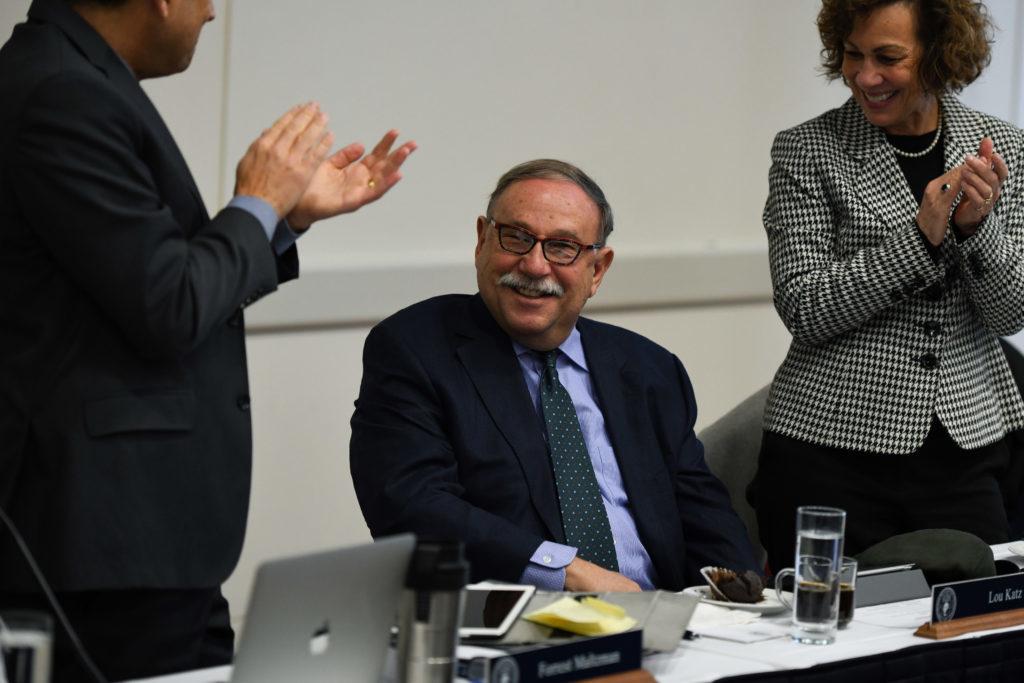For nearly three decades, Lou Katz guided GW from a little-known regional university into a global institution.
Faculty and former officials say Katz, who served as executive vice president and treasurer for 27 years, worked behind the scenes on some of the University’s most transformative decisions in recent decades. During his tenure, which spanned three University presidents, Katz became a powerful figure in Rice Hall, overseeing a far-reaching office that controlled the University’s financial and campus development operation.
Katz announced last week that he would leave his role this summer to become a special advisor to University President Thomas LeBlanc and then plans to retire at the end of 2018.
Katz was a cornerstone of former University President Stephen Joel Trachtenberg’s administration and the only senior Trachtenberg official to last the entirety of former University President Steven Knapp’s decade-long stay. His departure will mark the first time in decades that a Trachtenberg-appionted official will not occupy a senior position at GW.
At a Faculty Senate meeting Friday, LeBlanc said Katz helped transform GW because of his work to expand the Foggy Bottom Campus.
“His legacy will live on in buildings that we were able to build because of his work and in the support for academic programs made possible because of his wisdom and his investment in University assets,” LeBlanc said.
Nelson Carbonell, the chairman of the Board of Trustees, said Katz was known for concocting creative solutions to the University’s financial woes. It was Katz who came up with the idea to use revenue from GW’s ownership of The Avenue development on I Street to fund construction for the Science and Engineering Hall when planned fundraising flopped, Carbonell said.
“That type of thinking – we’re going to take this piece of property and generate revenue that allows us to support the academic enterprise, those are really unique ways Lou Katz has thought about the institution,” he said.
Katz, through a University spokeswoman, did not return a request for an interview for this story.
“The opportunity to serve GW as the institution evolved into a world-class university has been a tremendous honor,” Katz said in a release announcing his retirement.
Building a legacy
Robert Chernak, the former senior vice provost and vice president of student and academic services who worked with Katz for more than two decades, said he will leave a legacy of financial and physical campus growth.
“He understood the importance of the quality of the student experience and the academic enterprise, and his decision-making always incorporated a sensitivity to these important aspects of University life,” he said in an email.
Trachtenberg said Katz was one of the best administrators he hired during his 19-year tenure as University president because of his dedication to students and long-term thinking about GW’s financial strategy.
During Katz’s tenure, the University grew its endowment by more than $1 billion to a total of more than $1.5 billion – an amount that is nearly matched by GW’s roughly $1.5 billion debt.
“I slept soundly knowing that Lou Katz was watching GW’s resources when the market was up and when it was down,” Trachtenberg said in an email.
Katz pioneered the University’s long-standing practice of investing in valuable D.C. real estate, a strategy that’s become the financial backbone of the University. GW invested more than $1 million in real estate last fiscal year, according to a financial report.
Katz oversaw GW’s acquisition of the Mount Vernon Campus in 1997 and the Virginia Science and Technology Campus in 1981 – moves that added more than 120 acres to GW’s real estate ownings. In Foggy Bottom, Katz guided the acquisition of the Textile Museum in 2012 and the Corcoran School of the Arts in 2014.
He was perennially among GW’s highest-paid employees, earning more than $1 million in fiscal year 2015 – the most recent year for which data is available. His salary occasionally outpaced the University president’s and was double what administrators in equivalent positions made at peer schools.
Through ‘rough waters’
There was no shortage of controversies and challenges during Katz’s time at the University, especially regarding the ways he decided to fund University projects.
Trachtenberg said during unstable times Katz had a talent for finding solutions to difficult problems. He worked with Katz alongside medical school leadership to sell part of its stake in GW Hospital, ridding the University of a $40 million deficit.
“He stayed calm in rough waters,” Trachtenberg said. “He never blinked when confronting a challenge.”
In nearly 30 years, there were challenges. After initial plans to use donations to fund the $275 million Science and Engineering Hall fell through, he had to resort to other revenue sources after fundraising failed to meet expectations.
Professors in the business school partially blamed Katz for the firing of former Dean Doug Guthrie, who was forced out after overspending the school’s budget by millions of dollars.
Katz also helped develop a strategy to refinance the University’s debt from Trachtenberg’s campus expansions. When graduate enrollment missed projections in 2014, Katz oversaw several rounds of academic and administrative budget cuts.
In 2016, Katz announced plans to pay off the University’s ballooning debt with property revenues over a five-year period. A debt report last fall showed some progress with his plan after more than $150 million paid off in September.
Henry Nau, a professor of international affairs, said Katz and Trachtenberg worked together to build their vision for the University, with Katz taking a less public role in the University’s decisions.
“Look, Trachtenberg was kind of a strategist, Lou Katz was kind of the implementer,” he said.
During his tenure, the Foggy Bottom Campus grew rapidly with new buildings like the Elliott School of International Affairs, the Milken Institute School of Public Health and District House. The expansions angered residents of the surrounding neighborhood, especially during Trachtenberg’s time.
“His legacy is one that ought to be recognized and put in context,” Nau said. “The campus really took shape.”
Don Parsons, a professor of economics who has criticized University construction projects in the past, said Katz is not necessarily responsible for some of the negative effects that faculty faced from increased spending during the Trachtenberg and Knapp administrations.
“His job, which he carried out as best he could, was to finance whatever they were going to do,” he said.
Moving forward
Parsons said it is “about time” for a new administrator in the role, potentially someone with a more up-to-date financial strategy.
University spokeswoman Maralee Csellar said officials will discuss transition plans for Katz’s position in the coming months.
Despite financial woes in recent years, Katz leaves the University during a period of growth, having ended last fiscal year with a $100 million surplus.
At the Faculty Senate meeting Friday, LeBlanc said Katz’s advisory role would be related to managing the University’s balance sheet.
“There’s no question as we got a little more derelict with the Carbonell administration, as I like to call it, he’s let things go that might have led to a treasurer refusing or resigning,” Parsons said.
Caitlyn Phung contributed reporting.





